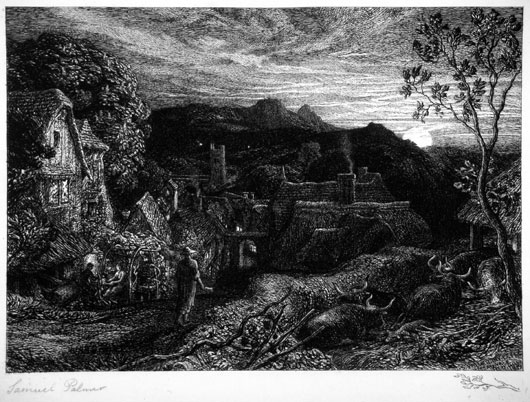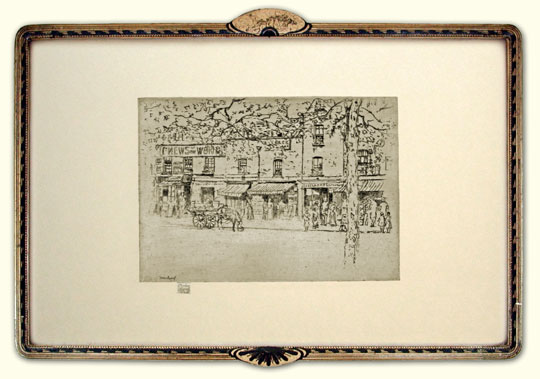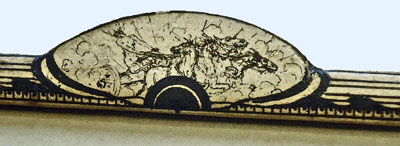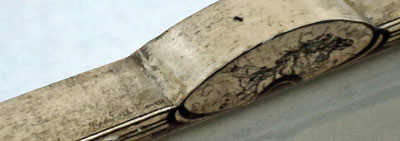A
Selection of Prints by Modern
British Artists
This
link: Modern
British Artists 02, will allow you
to view the featured prints from the
subsequent selection of Modern British
Artists |
|
See
also :
Click
on a thumbnail (left)
to link directly with the entry for that
print, or scroll down to view all this month's
selection. Images are not at very high resolution.
If
you require further information on any
print featured here, please contact
us. Some
of these prints have since been sold and
are marked as Sold.
|
|
|
|
 |
|
SAMUEL
PALMER
London 1805 – 1881 Reigate
Palmer
wrote of his “great gorge of old
poetry to get up the dreaming” when
he worked at etching. Most of his plates
are inspired by poems. The two late great
plates The Bellman and The Lonely
Tower relate to the same passage from
Milton’s Il Penseroso –
“ – the
Belman’s drowsie charm,
To bless the dores from nightly harm:
Or let my Lamp at midnight hour,
Be seen in some high lonely Towr ”
The
Bellman
Lister 11 v/vii
190
x 251 mm (plate);
167 x 236 mm (image);
215
x 282 mm (sheet)
Original
etching, completed 1879. Signed in pencil.
Fifth state with the etched remarque in the
plate border. One of 60 such proofs issued
1879 by The Fine Art Society, prior to the
lettered edition. A fine impression on laid
paper. Overall in very good condition. A
short repaired tear at the right sheet edge
and a few tiny foxmarks in the lower margin.
£15000
The
village is a recollection of Shoreham “a
dream of that genuine village, where I mused
away some of my best years” though
its surrounding landscape is made up.
Return to top ^ |
|
|
|
|
|
JAMES
McNEILL WHISTLER
Lowell, Massachusetts 1834 – 1903 London
Nude
Model reclining
(Ref: Spink 73 ii/iii, before the spot erased
on the shoulder)
Transfer lithograph with stump work, 1893.
One
of 22-40 life-time impressions printed for
Whistler by Way.
On antique laid paper.
£7500
Return to top ^ |
|
|
|
|
|
GERALD
LESLIE BROCKHURST R.A., R.E.
Edgbaston 1890 – 1978 New Jersey
Among
the awards which Brockhurst won as a student
at the Royal Academy Schools was a Travelling
Scholarship, which took him to Italy in 1913.
Piero della Francesca, Leonardo and his Lombard
followers, the mannerist Bronzino, were long
lasting influences on his highly finished
realism, delight in chiaroscuro and capturing
of the contrasting textures of fabrics, as
well as the occasional landscape background.
It
was exclusively in some of his finest etched
portraits, produced 1928-1932, that Brockhurst
adopted the Italian Renaissance format of
the sitter posed either literally against
an open window, as in Viba, with a view to
a distant hilly landscape (generally reminiscent
of Umbria), or the window frame is suggested
by the inked bevelled edge of the plate itself.
Viba
Wright 63 i/viii 227
x 175 mm
Original
etching, 1929. Signed in pencil. A trial
proof in the 1st state, before the plate
was reduced to 213 x 170 mm removing the
window frame at the top and at the left side.
Before the plate was dated, though with the
signature. Before additional hatching and
increased shadow at the left. Before the
bevelling of the plate. On wove paper.
Sold
Return
to top ^ |
|
|
|
|
|
TERRY
FROST R.A.
Leamington Spa 1915 - 2003
Frost
described his work as presenting the sensations
of movement through space, time, light, weather,
and the emotional reaction to a particular
moment and place, rather than representing
their physical appearance. He created an
abstract visual poetry through an exuberance
of intense luminous colour.
Much
of his work was created in St. Ives and Newlyn
and is generated by his perception of the
movement of boats and light on water.
“I
was not portraying the boats, the sand,
the horizon, or any other subject matter,
but concentrating on the emotion engendered
by what I saw. The subject is in fact the
sensation evoked by movements and the colours
of the harbour”.
Tolcarne
Rhythm
392 x 275 mm
Original
colour aquatint, 1998. Signed in pencil,
dated, entitled and numbered 112/175. Published
1998 for the Big Issue Art Collection to
raise funds for The Big Issue Foundation
to help the homeless. On wove with margins.
The colours vibrant.
Sold
Return to top ^ |
|
|
|
|
|
STANLEY
REGINALD WILSON
Camberwell 1890 – 1973 London
Gull
at Sunset, in the Scottish Islands
304 x 402 mm
Original
colour drypoint and aquatint. With the drypoint
signature in the plate. Signed in pencil.
And with the blind monogram stamp. Printed
by Wilson. Though an edition of 100 was proposed,
(this impression is numbered 4/100 ) it is
very unlikely that many impressions were
printed, considering the complexity of the
number of coloured inks involved. Printed à la
poupée from two plates, in powder
blue, pink, green, crimson, orange, yellow,
brown, ochre, purple, Prussian blue, grey
and black, on thin japan. The colours vivid.
£1250
Wilson’s
colour etchings are generally extremely rare
and all his plates were destroyed by bomb
damage in the War. I have never seen this
subject before.
Return to top ^ |
|
|
|
|
|
JEFF
CLARKE R.E.
Born Brighton 1935
As
a student at Brighton School of Art, 1952-56
Jeff Clarke was taught etching by Raymond
Cowern, who belonged to that generation trained
in the 1930’s in the traditions of
the Etching Revival, before the cultural
divide effected by the Second World War.
Under Cowern’s tutelage Jeff received
a British Institute scholarship and won the Prix
de Rome for engraving, 1956-8. In Rome
Jeff’s interests took a different turn
and painting became his preoccupation. He
would only return to etching decades later.
Only two impressions from his student days
survive, both unique trial proofs. The copper
plates both long gone, as the ethos in which
they were etched. Both are delightful evocations
of an earlier era of etching, though his
present interest in chiaroscuro and telling
silhouette is already in evidence.
Rue
Pequet, Dieppe
163 x 74 mm
Original
etching, 1954. Signed in pencil and annotated Dieppe
1954 Trial proof. On laid paper. Verso
very pale glue stains from previous mounting
in the top and bottom margins.
£500
Return to top ^ |
|
|
|


Detail
of the ‘Phaeton’ motif on the
top medallion of the frame, above
and detail of the signature on the top of the
frame, below


Detail
of another (more legible) signature from
the side of the frame
|
|
THEODORE
ROUSSEL
Lorient, Brittany 1847 – 1926 St Leonards
on Sea
Quite
exceptionally, to display the etchings at
his first one-man show in 1889, Roussel designed ‘etched’ frames
in two different patterns. In 1907-08 he
designed two further patterns, this time
for frames with rounded corners, which were
first used to exhibit his monochrome etchings
in 1908. The
Phaeton frame, named from the motif in the
upper medallion, was one of the latter.
Roussel
etched four patterned strips, each with an
etched signature, onto a copper plate. The
resulting impressions, printed in black ink
onto ‘white’ paper, were cut
to form paper segments which were glued onto
narrow convex wooden mouldings to make the
finished frame, which was varnished to preserve
the paper veneer.
Only
about 10 frames in each design were completed
and it is unknown how many (or perhaps how
few!) have survived but they are certainly
very rarely encountered.
The
Street, Chelsea Embankment,
in an original etched Phaeton
Pattern frame
Hausberg 26 (etching), 166 (frame pattern) 281
x 405 mm (frame size, including the medallion
extrusions)
Sold
The
Etching
Original etching, 1888-89. The
plate signed. Printed by Roussel and trimmed
by him on the platemark and signed in pencil
on the ‘tab’ (a practice in imitation
of Whistler). One of about 40 impressions in
total. Printed with plate-tone on laid paper,
the plate-tone disturbed in the lower left
corner. One foxmark at the lower edge.
A
row of shops, formerly 83-88 Cheyne Walk,
which were demolished in 1889 in connection
with the rebuilding of Battersea Bridge.
The signboards for Clarke’s coffee
rooms and Weller’s, dealer in furniture,
(as well as a currently topical advert for
the News of the World) are legible.
The other shops were Cole’s, photographer
and coffee shop; Groves, and Nicholas, both
tobacconists.
The Frame
Original etched strips
applied to a round-cornered moulding and varnished,
as described above. Signed on each reverse
side.
Provenance:
Agnes Ethel Mackay, the niece of Roussel’s
second wife, who after her aunt’s death
in 1917 acted as housekeeper and studio assistant
to Roussel.
Miss
Mackay lent this frame to the Roussel
Memorial Exhibition at Goupil in 1927, the
year after the artist’s death. The
associated labels, which indicate “Not
for Sale”, still intact on the
back of the frame, with her address 15 Upper
Cheyne Road, Chelsea.
Return to top ^ |
|
|
|
|